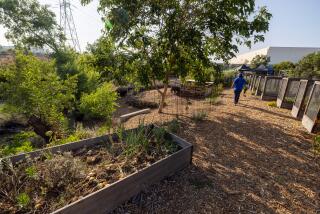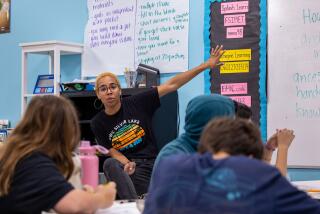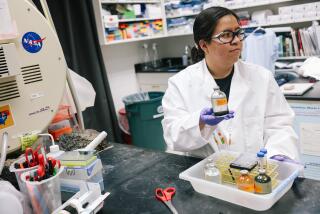COSTA MESA : Blending, Clarifying the Sciences
- Share via
When Brent Neumeyer’s seventh-grade science students ask why the day’s lesson will be important to them, the Costa Mesa High School teacher has an unusual way of answering.
He might put a cup of hot water with two holes in it into a pan filled with room-temperature water, and tell his students to watch what direction the water, which has been dyed with food color, travels.
If done correctly, the demonstration should show that hot water rises and cold water settles. With that knowledge, Neumeyer said, the students can discuss ocean currents and their effect on the weather.
The experiment, a combination of oceanography and chemistry, is one of a variety of techniques that Neumeyer uses in a course he developed to show the interrelationship of the sciences, from astronomy to paleontology.
“From a kid’s point of view, where does oceanography begin and end?” he asked. “We’re really trying to weave things together because, for a kid, it’s more meaningful.” Neumeyer’s course was started with an initial $6,500 grant from California Educational Initiatives Fund, a private foundation. Eventually, it will be offered to seventh-, eighth- and ninth-graders in the Newport-Mesa Unified School District. Next week, he expects to get another $10,500 grant to continue the project.
The fund, which BankAmerica Corp. began in 1979, is supported by 11 private corporations that have given almost $1 million a year in grants for educational projects that benefit public schools, students and the community, according to Joanne El-Gohary, the fund’s administrator.
The foundation issued 93 grants totaling $770,000 for the 1990-91 school year. Only seven of those went to schools in Orange County.
In traditional science classes, students learn about the human body in biology and the physical aspects of the ocean in oceanography, but in Neumeyer’s class, students learn the relationships between the sciences and how they are similar or overlap.
“During the course of a year or two years, the kids never hear that taking biology or chemistry or geology,” said Neumeyer, sitting in a chemistry lab where the walls are dotted with solar-system charts and the blackboard has complex equations scrawled across it.
He takes a chronological approach with his 240 students, beginning with the galaxy, then focusing on the earth. The next lesson will be the equivalent of ecology, although it won’t be limited to that, he said. Instead, Neumeyer plans to broaden the lesson, giving students knowledge they’ll need to make informed decisions about events in the news today.
“If you can’t connect knowledge to anything, it doesn’t make sense,” Neumeyer said. “Kids often ask, ‘What does this have to do with anything?’ We’re trying to answer the question, ‘What,’ but if you break it into too many compartments, you only answer part of ‘why.’ ”
More to Read
Sign up for Essential California
The most important California stories and recommendations in your inbox every morning.
You may occasionally receive promotional content from the Los Angeles Times.










